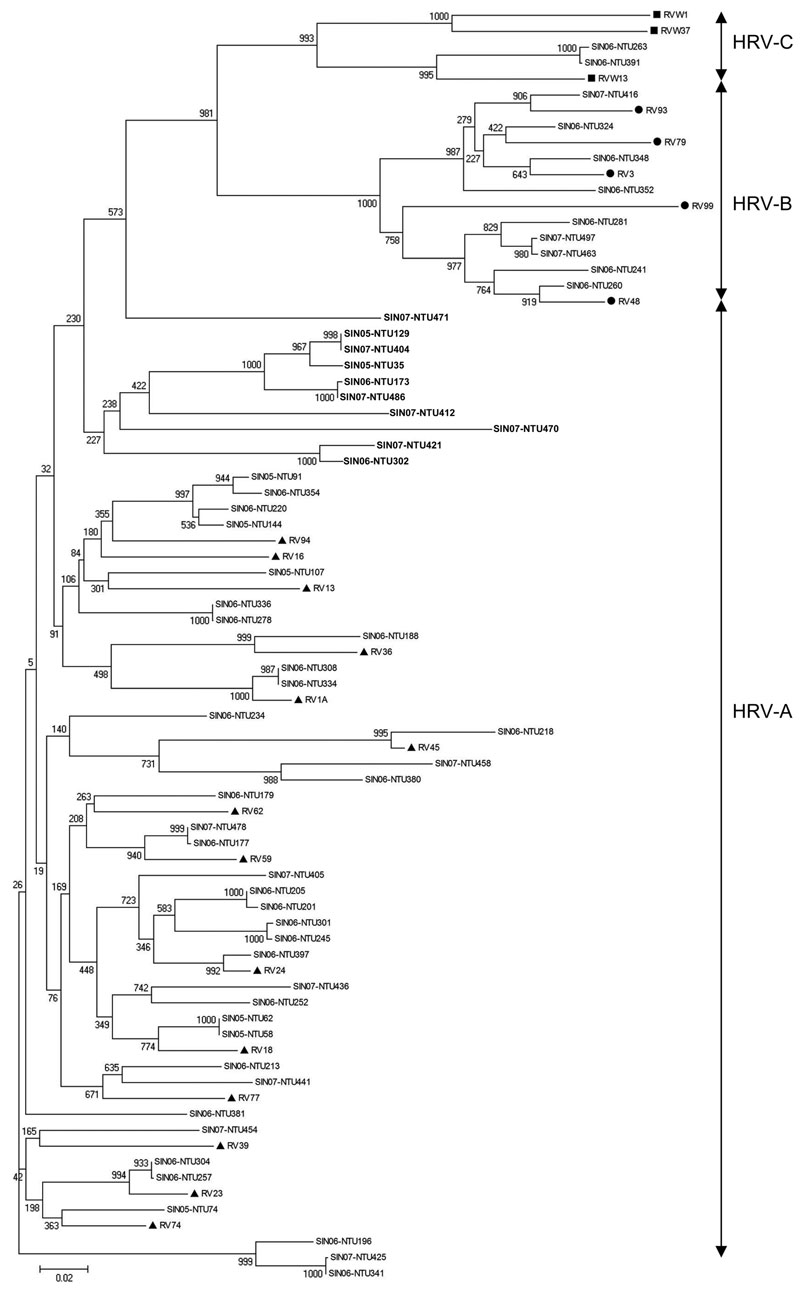Volume 15, Number 8—August 2009
Letter
Human Rhinovirus Group C in Hospitalized Children, Singapore
Figure

Figure. Phylogenetic analysis of human rhinoviruses (HRVs) from Singapore based on nucleotide sequences of the 5′ noncoding region. The tree was constructed by using the neighbor-joining method with 1,000 bootstrapped replicates generated by MEGA version 4 software (9). Sequences (GenBank accession nos. FJ645828–FJ645771) of viruses from Singapore (SIN) are indicated, where the 2 numbers represent the year the specimen was collected, and NTU (Nanyang Technological University) followed by 3 numbers represents the specimen number. Representative strains of HRV-C are indicated by squares, HRV-B by circles, and HRV-A by triangles. RV indicates rhinovirus strains, followed by the serotype no. These sequences were obtained from the report by Lee et al. (3). Boldface indicates a cluster of 10 HRV-A strains that diverged from reference HRV-A strains. Scale bar indicates nucleotide substitutions per site.
References
- Lamson D, Renwick N, Kapoor V, Liu Z, Palacios G, Ju J, MassTag polymerase-chain-reaction detection of respiratory pathogens, including a new rhinovirus genotype, that caused influenza-like illness in New York State during 2004–2005. J Infect Dis. 2006;194:1398–402.DOIGoogle Scholar
- Lau SK, Yip CC, Tsoi HW, Lee RA, So LY, Lau YL, Clinical features and complete genome characterization of a distinct human rhinovirus (HRV) genetic cluster, probably representing a previously undetected HRV species, HRV-C, associated with acute respiratory illness in children. J Clin Microbiol. 2007;45:3655–64.DOIGoogle Scholar
- Lee WM, Kiesner C, Pappas T, Lee I, Grindle K, Jartti T, A diverse group of previously unrecognized human rhinoviruses are common causes of respiratory illnesses in infants. PLoS One. 2007;2:e966.DOIGoogle Scholar
- McErlean P, Shackelton LA, Lambert SB, Nissen MD, Sloots TP, Mackay IM. Characterisation of a newly identified human rhinovirus, HRV-QPM, discovered in infants with bronchiolitis. J Clin Virol. 2007;39:67–75.DOIGoogle Scholar
- Xiang Z, Gonzalez R, Xie Z, Xiao Y, Chen L, Li Y, Human rhinovirus group C infection in children with lower respiratory tract infection. Emerg Infect Dis. 2008;14:1665–7.DOIGoogle Scholar
- Loo LH, Tan BH, Ng LM, Tee NW, Lin RT, Sugrue RJ. Human metapneumovirus in children, Singapore. Emerg Infect Dis. 2007;13:1396–8.
- Tan BH, Lim EA, Seah SG, Loo LH, Tee NW, Lin RT, The incidence of human bocavirus infection among children admitted to hospital in Singapore. J Med Virol. 2009;81:82–9.DOIGoogle Scholar
- Hayden FG, Turner RB, Gwaltney JM, Chi-Burris K, Gersten M, Hsyu P, Phase II, randomized, double-blind, placebo-controlled studies of ruprintrivir nasal spray 2-percent suspension for prevention and treatment of experimentally induced rhinovirus colds in healthy volunteers. Antimicrob Agents Chemother. 2003;47:3907–16.DOIGoogle Scholar
- Tamura K, Dudley J, Nei M, Kumar S. MEGA4: Molecular Evolutionary Genetics Analysis (MEGA) software version 4.0. Mol Biol Evol. 2007;24:1596–9.DOIGoogle Scholar
- Miller EK, Edwards KM, Weinberg GA, Iwane MK, Griffin MR, Hall CB, New Vaccine Surveillance Network. A novel group of rhinoviruses is associated with asthma hospitalizations. J Allergy Clin Immunol. 2009;123:98–104.DOIGoogle Scholar